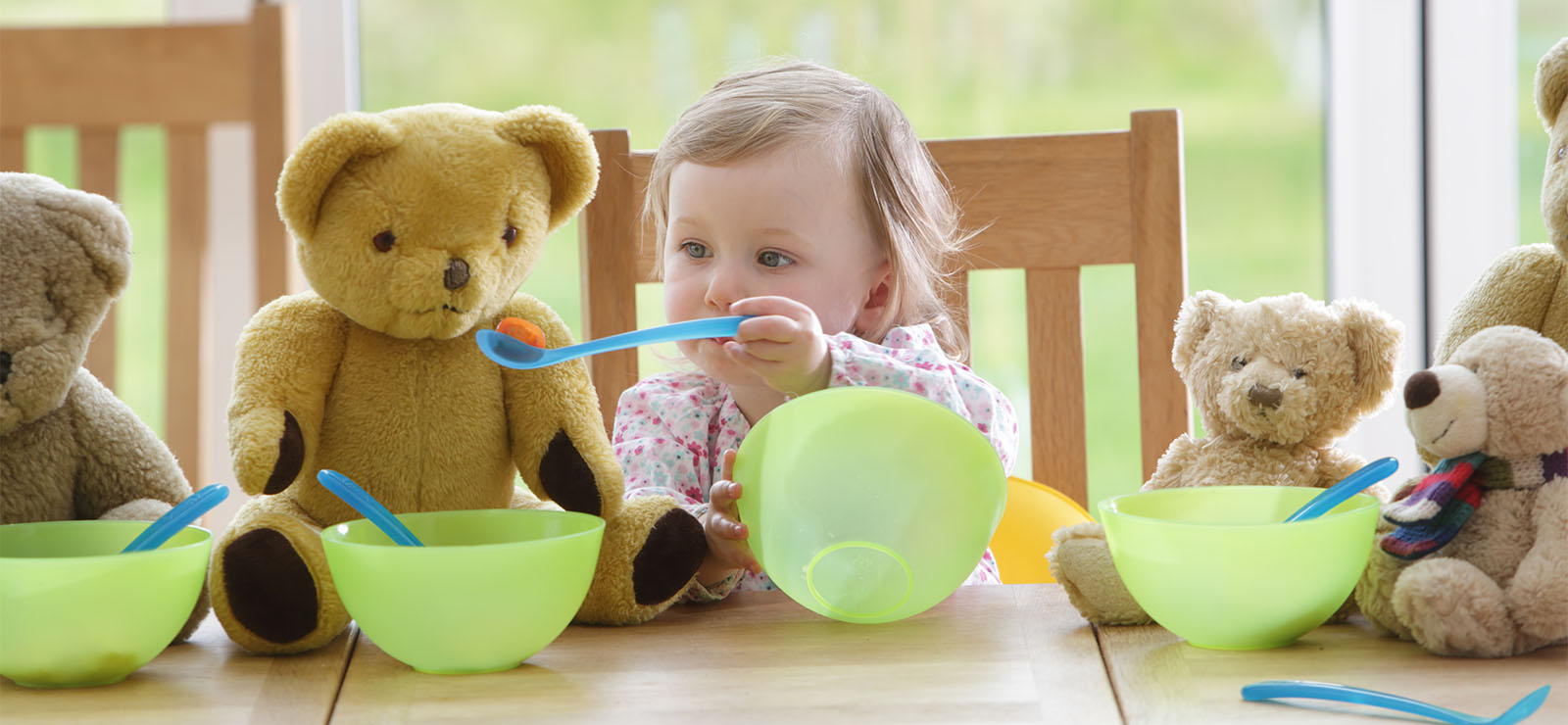January 22, 2025

While any play with your child is beneficial for their mental health — it helps cement the parent-child bond — how you play with your children is also important. Knowing which questions to ask, what language to use and how to direct your child during play helps ensure they’re developing physically and mentally — and at the appropriate level.
To provide some playtime pointers, we turned to two MU Health Care experts:
- Michelle Dampf, speech-language pathologist
- Jessie Nicolaescu, occupational therapist
These certified child experts previously developed our gift guide for developmentally appropriate toys. Now, they’re here to guide you in how to get the most out of your time spent playing with them with your child.
Infants: 0 to 12 months
When you bring your newborn home from the hospital, you may not be thinking about “playing.” But any interaction that engages your baby’s senses is a form of play.
As your infant progresses through their first year, keep these tips in mind:
Get Your Child’s Attention
During their first year, babies increase their ability to focus. Start by simply trying to get your child’s attention. See if you can get them to turn their head towards different sounds and frequencies. Later, work on keeping their attention on whatever you are focusing on (like a book or a toy).
“Just because your child can hear something doesn’t mean they are listening,” Dampf says. “The goal is for them to turn their head and pay attention to what they hear.”
Make Them Work for It
Playing on the floor at this age encourages the most movement. But pay attention to where you place the toys.
“You want younger babies to reach for toys, shifting their weight when on their tummies,” Nicolaescu says. “Putting toys over to the side or a little bit out of the way can motivate older infants to work on rolling and find a way to get it.”
Take Turns
As you near your child’s first birthday, introduce the concept of taking turns. “First, I push it. Then, you push it.” This skill requires an increased attention span and listening skills, and it’s a playing skill you’ll practice on repeat for the next few years.
Toddlers: 1 to 2 years
A parent or caregiver is often a toddler’s favorite playmate. Take advantage of the time together to help them develop by:
Keep Your Language Short
Labeling what you are playing with is a great way to encourage speech and vocabulary. A good rule of thumb is to make your phrases just one word more than your child uses.
“If your child is using one word, saying “ball” for instance, then you might say “red ball” or “big ball,” Dampf says.
Challenge Your Child
Problem-solving activities are great for this age, Nicolaescu says. If you can get them moving at the same time, it’s even better.
“Place things just a bit out of reach so that they have to figure out how to get to it,” she says. “Have them pick up their blocks but put the bin across the room. They’ll need to figure out how many blocks they can carry at once and whether they’ll walk back and forth or bring the bin closer.”
Let Them Come to You
Toddlers are busy and thrive on your attention. An easy way to play with them is to let them bring you toys and engage with you.
“The biggest tip I tell parents of any age child is to just sit on the floor with your child — without your phone,” Dampf says. “They will bring you toys and show you how they want to play.”
Preschoolers: 2 to 4 years
Preschoolers rarely sit still, so much of their playtime may involve movement. “They have so much energy and are figuring out how to move their bodies,” Nicolaescu says.
But when they aren’t running around, incorporate these tips into playtime:
Ask Who? What? and Where?
Asking your preschooler about who was involved and what happened helps with critical thinking. But Dampf says to avoid asking questions about when, how or why.
“These concepts can be difficult for kids this age to understand,” she explains. “Save them for when your child is 5 or 6.”
Play Pretend
Kids this age love to pretend, and it gives them a chance to imitate their favorite adults.
“Pretend play is an excellent way to work on building language, conversing with others and following directions,” Dampf says. “Plus, it’s fun to watch your kids being creative.”
Get Them to Grasp
Developing fine motor skills in preschool gets them ready for writing. You can work on your child’s grasp pattern (how they hold things with their fingers) by drawing with crayons or pencils. During pretend play, have your child use tongs to grab their food — it’s a great way to mimic the skills they’ll need to use scissors.
Grade Schoolers: 5 to 9 years
Once they reach grade school, children get their first taste of independence and are developing social skills. You can work on both while you play:
Talk About Your Feelings
You may find yourself playing a lot of board games with your grade-schooler. When you do, use it as an opportunity to show your child how to express their feelings.
“Kids this age have big feelings,” Dampf says. “They don’t always have the words for them and often turn to actions instead. When something happens in a game, express your feelings and model appropriate behavior.” Start with simple feelings, explaining that you feel mad, happy, sad or scared. Later, move onto more complicated feelings like being frustrated, embarrassed or jealous.”
Incorporate Life Skills
School-age kids want to feel independent, and there are plenty of ways to teach life skills while you play. If your child still loves pretending, have them count out or manage money while they pretend to have a store or restaurant. Or use a simple recipe and cook with your child — it also helps with following multi-step directions.
“Pretending and real-life playing gets a little more elaborate at this age,” Nicolaescu says. “But it can be fun and educational.
Preteens: 10 to 12 years
The biggest challenge at this age is getting kids away from electronics. If you can do that, use these tips to make the most of your teen’s time and attention:
Let Them Talk
Kids in middle school may not always feel like they can say what’s on their mind to their schoolmates — they run the risk of ridicule. But you can create a safe space at home.
“Just get your child in the same vicinity as you,” Dampf says. “And try not to do the talking. The quieter you are, the more talkative they will become.”
Follow Their Lead
If you get some time with your tween, offer to do whatever they are interested in. If that means playing video games, then grab a controller and cherish the time.
When your child comes to you with a dilemma, help, but don’t solve it for them. Hint at some ways they might handle the situation and ask what they think.
Next Steps and Useful Resources
- Want to discuss more with a pediatrician? Find one today.


